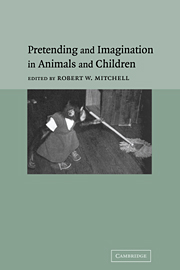Book contents
- Frontmatter
- Contents
- List of contributors
- Foreword by Sue Taylor Parker
- Preface and acknowledgments
- I Historical, developmental, and comparative overviews
- II Pretense and imagination in children
- 4 Language in pretense during the second year: what it can tell us about “pretending” in pretense and the “know-how” about the mind
- 5 A longitudinal and cross-sectional study of the emergence of the symbolic function in children between 15 and 19 months of age: pretend play, object permanence understanding, and self-recognition
- 6 Caregiver-child social pretend play: what transpires?
- 7 Just through the looking glass: children's understanding of pretense
- 8 Young children's understanding of pretense and other fictional mental states
- 9 Pretend play, metarepresentation and theory of mind
- 10 Replica toys, stories, and a functional theory of mind
- 11 Young children's animal-role pretend
- 12 Imaginary companions and elaborate fantasy in childhood: discontinuity with nonhuman animals
- III Pretense and imagination in primates
- IV Prospects
- References
- Author Index
- Subject Index
4 - Language in pretense during the second year: what it can tell us about “pretending” in pretense and the “know-how” about the mind
Published online by Cambridge University Press: 13 August 2009
- Frontmatter
- Contents
- List of contributors
- Foreword by Sue Taylor Parker
- Preface and acknowledgments
- I Historical, developmental, and comparative overviews
- II Pretense and imagination in children
- 4 Language in pretense during the second year: what it can tell us about “pretending” in pretense and the “know-how” about the mind
- 5 A longitudinal and cross-sectional study of the emergence of the symbolic function in children between 15 and 19 months of age: pretend play, object permanence understanding, and self-recognition
- 6 Caregiver-child social pretend play: what transpires?
- 7 Just through the looking glass: children's understanding of pretense
- 8 Young children's understanding of pretense and other fictional mental states
- 9 Pretend play, metarepresentation and theory of mind
- 10 Replica toys, stories, and a functional theory of mind
- 11 Young children's animal-role pretend
- 12 Imaginary companions and elaborate fantasy in childhood: discontinuity with nonhuman animals
- III Pretense and imagination in primates
- IV Prospects
- References
- Author Index
- Subject Index
Summary
Pretend play is a fascinatingly complex behavior from which psychologists have drawn information on a wide range of children's functionings and developments. Piaget considered it as an important window through which to glimpse the incipient representational capacities of the child. Indeed, in pretend play, the abridged and schematized enactment of activities (or events) outside of their habitual context consists in the signifier, the trace evoking the real activities, the signified. The playful attitude, the abridged actions, enacted sometimes in an exaggerated manner, the inanimate co-participants, the miniature objects, the repetition of actions lacking material results, the simulation of physical sensations in the absence of relevant physical stimuli, the displacement of the activity relative to its habitual setting, etc., are all indices that have been taken, separately or in combination, by authors trying to define and/or identify early manifestations of pretend in very young children (e.g., Piaget, 1945/1962; Inhelder et al., 1972; Nicolich, 1977; McCune-Nicolich, 1981; Veneziano, 1981; Musatti, 1986; Lillard, 1993a).
More recently, pretend play has attracted researchers' attention for the potential developmental links it may have with components of “theory of mind.” Indeed, the representational aspect of pretend play implies children's ability to consider one object as simultaneously having the properties it has in “real” life and those that it has by virtue of the meaning transformation it has undergone in pretend. The ability to hold double representations about a single entity is also necessary for a theory of mind.
- Type
- Chapter
- Information
- Pretending and Imagination in Animals and Children , pp. 59 - 72Publisher: Cambridge University PressPrint publication year: 2002
- 3
- Cited by



